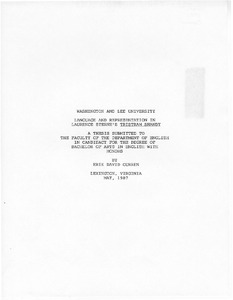| dc.description.abstract | The self-aware form of Tristram Shandy thus separates it from novels of its own century and from those of the century that followed it. It is less evident how the novel significantly differs from more recent texts, which show a similar concern with the method of novel-writing. English, American, and European literatures of the twentieth century century boast traditions of self-conscious novels, frequently called "metafictions." "Metafictional novels," Patricia Waugh explains, "tend to be constructed on the principle of a fundamental and sustained opposition: the construction of a fictional illusion (as in traditional realism) and the laying bare of that illusion." Tristram Shandy differs from much twentieth-century metafiction in that it refuses to construct the illusion of a linear, progressive story, but instead admits that it is, as a novel, saddled with this conventional expectation. It uses the awareness of the illusion it "should" be creating to show how fictive any representation of the people, actions, and temporal progression of the phenomenal world really is. Metafictive novels sacrifice the telling of a good tale for an emphasis on form. Gerard Genette develops this opposition as
that between histoire and discours, or story and narrative discourse. The story of a novel is the "succession of events, real or fictitious, that are the subjects" of the novel. The discourse, on the other hand, is the narrative statement, which "undertakes to tell of an event or a series of events. In metafictional texts, narrative discourse is more apparent than story, the mode of telling is more apparent than the tale itself, whereas in realist texts, narrative discourse is more transparent -- it does not draw attention to itself by interrupting the story in some way. [From introductory section] | en_US |
| dc.rights | This material is made available for use in research, teaching, and private study, pursuant to U.S. Copyright law. The user assumes full responsibility for any use of the materials, including but not limited to, infringement of copyright and publication rights of reproduced materials. Any materials used should be fully credited with the source. | en_US |
